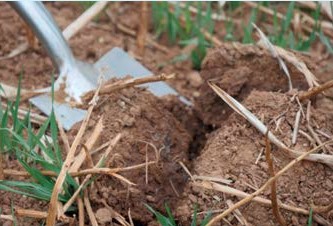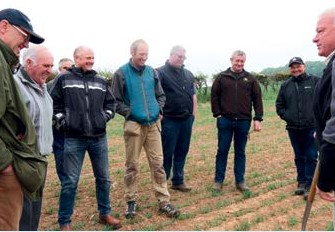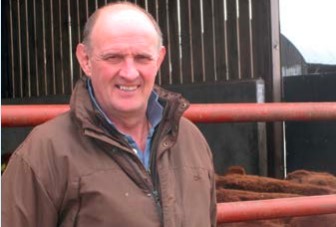while listening to Radio 1)

John Aynsley, runs a 1,302ha mixed farm near Saltburn-by-the-Sea in the north east of England. Barn Farm with 566 ha of arable cropping in a predominantly cereals rotation has recently seen a system change to direct drilling. The transition has been followed and directed by the local AHDB Monitor Farm programme group. Read on to hear about this journey and John’s early conclusions…
Looking back through the mists of time to the 1970/80’s, when as a young man, ploughing was just what you did to start to prepare a seed bed to plant a crop. This was followed by double discing, harrowing, drilling and finally if it had not all got too wet, rolling. Radios were blaring out Radio 1 that you could not really hear above the noise of the tractor, while you were bouncing around in basic cabs. Happy days. The soils turned over beautifully, smelled wonderful and earthy, loads of worms and seagulls munching their way through them. Then power harrows appeared, WOW, one pass following the plough then drill and roll. Then we got really clever and put the drill on top of the power harrow, the combination was born. We thought we were really good then, more hp, more weight, better radios and CD`s and cab suspension. The halcyon days.
And it all worked well and still does for many businesses, drilling seeds/sq.m a lot more accurately, with more even crop emergence and establishment, and lower labour and fuel costs. It was only moving from energetic and naïve youthfulness into middle age, that I saw that the very soils that we once turned over so beautifully, that were so fibrous with organic matter and worms, had become depleted into poorer soils that with the first shower of rain became more difficult to work. How had this crept up behind me without really being aware of it? That was the light bulb moment when I knew we had to start to change.
Starting out on the journey to change
Our rotations had become too short and relied too much on OSR to be our saviour, there was no grass or livestock in the rotation. What would previous generations have made of this I wonder, probably already knowing the answer.

So, the journey to direct drilling had started, but like a lot of things in life it is never a straight or smooth road. It was certainly helped by attending a conference at Driffield in 2011 and listening to different people share their knowledge and experience of the move toward min till, direct drilling or regen agriculture, whatever you want to call it. It was at this point that I met Steve Townsend, who started to help us make that transition to better soils and different establishment methods. At first my agronomist David Coates and I had many discussions and brain storming sessions around the kitchen table, to try to understand exactly what Steve was advising us to look at and move towards.

To start with we did more soil sampling looking at a wider analysis, and in our case, it was showing an imbalance between the magnesium and calcium ratios. Once we started to correct this imbalance our soils have become easier to work with, had a bit more tilth in the top few inches and didn’t revert to a plasticine consistency when things get a bit wet. It will always be work in progress, but you have to start somewhere. The transition to min till is fairly easy and straightforward once you figure out which cultivator and drill suits the farm and system you want to adopt. The next stage however is a bit trickier, this is when the mindset and focus are really challenged.
Monitor Farm programme opportunity
I was given the opportunity to become a monitor farmer as part of the AHDB programme. This gave me the chance to move from min till to direct drilling on 260 acres as part of a 3-year project. Once I had committed to that there was no going back, we would find out whether we could make it work or not. As part of the project, I had to form a Steering Group and we agreed our aims would be to include winter beans and cover crops in the rotation, try to control sterile brome which is our biggest grass weed problem, direct drill all beans and cereals, to see whether the effect of these changes starts to improve the soil and ask whether it can all be profitable.
We bought a second hand Horsch CO6 drill to do the direct drilling for £10,500. This has proved to be more than adequate for the job, it only needs 150hp on the front travelling at 7/8kph. One of the things that I have learned since we started min tilling and direct drilling is that the earlier we get the crops in the ground with a higher than normal seed rate the better they are. The one discipline that we try very hard to stick to is if the soil starts sticking to the tractor tyres get out of the field as it is too wet, and we will be doing more damage than good, hence the need to get on early.

We have been benchmarking the whole arable area through AHDB for several years now, so it is interesting to compare the different costs/income from min till and direct drilling. The 3-year Monitor Farm project is not really long enough to come to any firm conclusions about whether we have managed to achieve all our objectives, but we will continue to monitor the changes over the years ahead.
Early conclusions
What I can say with some certainty however is that direct drilling does work, it uses a lot less labour and fuel. First wheat and bean yields are equally as good as min till. The inclusion of winter beans into a wider rotation is helping improve the soil structure, where we have severe brome the use of cover crops and glyphoshate followed by minimal soil disturbance drilling is certainly working. As to the profitability, I think the weather still has probably the biggest influence over both systems. We are doing more direct drilling year on year and I am fairly sure that we are seeing the benefits of this through better tilth, increased worm numbers and soil smelling a lot better, although as it took some time for the soils to become depleted, it will take time for them to repair. We will have to allow mother nature to do her bit unimpeded by poor practice and hopefully this will help accelerate the process.
Moving to direct drilling I feel that we now have a better understanding of our soils and of what we should and should not do to them, but it is and always will be, work in progress. It does require more attention to detail and it certainly does not look as good to the eye until it gets above the stubble, but as long as it delivers profitability then the soils will improve and we will be able to lower our input costs.
